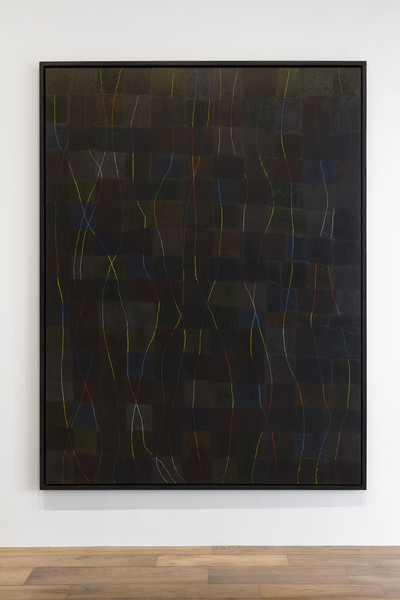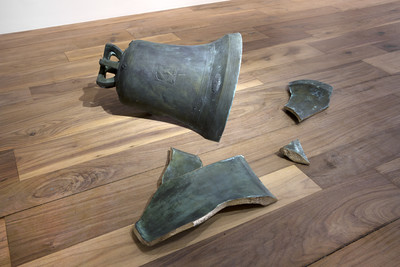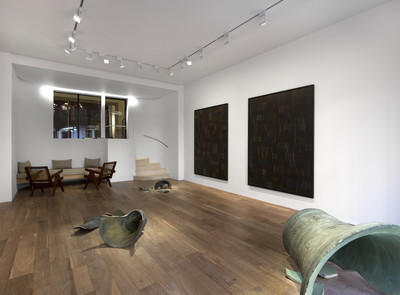















Giant bronze bells lie shattered across the floor. On the wall hang large canvases blackened in ink, the sediment of their childish colours appearing in naïve graffiti. For the inauguration of his new London space during Frieze, Kamel Mennour is pleased to present a series of new works by Latifa Echakhch. The French-Moroccan artist brings together the eddies of world history with the gestures of childhood. From the encounter, she redraws unknown contours: ‘Elsewhere… I want to live in this place where the gap between the functionality of a time, a thing, and where they have gone opens up infinite potentialities. Ruins speak to me. Not because they have gone under, but because of the paths they initiate.’
The bells have smashed to pieces in a final peal, deafening though forever lacking. Their silence reverberates through future time. A time when a chorus of voices will lift up from the monumental debris to ‘free the heavens’1. One can hear the voice of Zarathustra: ‘Free from the happiness of serfs, redeemed from gods and worship, fearless and fearful, great and solitary, that is how the will of the genuine man is.’2 The voice of the French Revolution and the fledgling Republic’s laws for desacralising the soundscape are evoked3. One hears, vibrating, the Romantic palpitations of hearts’ osmosis… An inaugural season, like childhood is.
Time’s lines transcribe strata of memory and forgetting in black ink. But behind appearances, nothing is effaced. The scribbles and joys of childhood are ready to break through the surface of the present. Latifa Echakhch has their ample movements appear intermittently in colourful crayon lines, the containers of our first, singular and universal emotions. Walter Benjamin once wrote: ‘the child’s apprehension of colour brings the sense of sight to its highest artistic development […] insofar as it isolates that sense. It elevates this development to a spiritual level.’4
At once above and below boundaries and forms, Latifa Echakhch performs gestures of flight, even as places in which to stand firm. Paul Celan would leave the mark of his own thunderbolt there:
‘From the visible, from the audible, the turning
free wordtent:
Together’ 5
Annabelle Gugnon
Born in 1974 in El Khnansa, Morocco, Latifa Echakhch lives and works in Fully (Switzerland).
Her work has been shown in France as well as abroad, in numerous solo exhibitions: at the Museum Haus Konstruktiv, in Zürich, the Centre Pompidou, the macLYON, the Hammer Museum in Los Angeles, the Kunstmuseum Liechtenstein in Vaduz, the Columbus Museum of Art (Ohio), Portikus in Frankfurt am Main, the Kunsthaus in Zürich, at the Museum Haus Esters in Krefeld, the MACBA in Barcelona, FRI ART in Fribourg, the GAMeC in Bergamo, the Kunsthalle Basel, the Bielefelder Kunstverein, the Fridericianum in Kassel, the Frac Champagne Ardenne in Reims, the Swiss Institute in New York, the Tate Modern in London and the Magasin - Centre in Grenoble; also in group shows: the MoMA PS1 in New York, the Palais de Tokyo and the Musée d’art moderne de la Ville de Paris, the Frac Nord-Pas de Calais in Dunkerque, the Centre d’art contemporain La Synagogue de Delme, the Centre d’Art Contemporain Genève, as part of the 11 Sharjah Biennial, the Aargauer Kunsthauss in Aarau, the Signal - Center for Contemporary Art in Malmö, the Den Frie Center of Contemporary Art of Copenhagen, the Kunsthalle Basel, as part of the 54th Venice Biennale, the Fundació Joan Miró in Barcelona, the Contemporary Arts Museum in Houston, at the GAM – Civic Gallery of Modern and Contemporary Art – in Turin, the Beirut Art Center, the CAC in Vilnius, as part of the Jerusalem Biennale ArtFocus and Manifesta 7 in Bolzano, at the Museum Anna Nordlander in Skellefteå, at the Studio Museum in Harlem, New York and at the Museum of Contemporary Art Chicago.
Winner of the 2013 Marcel Duchamp Prize and of the 2015 Zurich Art Price, Latifa Echakhch will present a solo exhibition at The Power Plant, in Toronto, from October 15th, 2016 to January 2nd, 2017.
















You are using an outdated browser.
Please upgrade your browser to improve your experience.